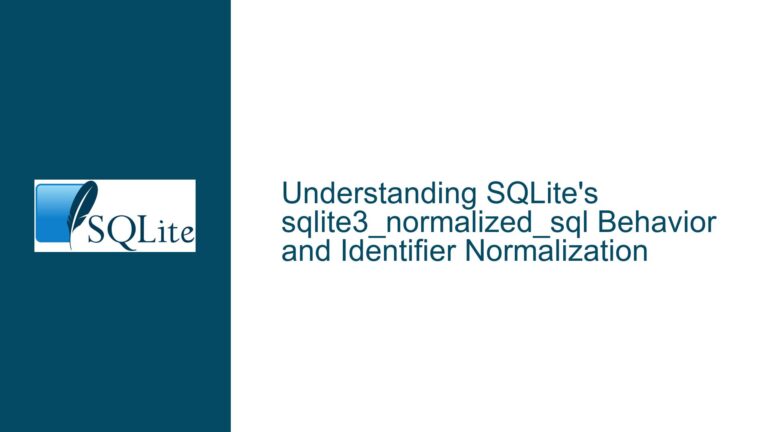SQLite Regression: Querying rowid on VIEW Fails in Newer Versions
Issue Overview: Querying rowid on a VIEW Fails in SQLite 3.38.5
The core issue revolves around a regression in SQLite where a query attempting to retrieve the rowid column from a VIEW fails in version 3.38.5, whereas the same query succeeds in earlier versions like 3.33.0. The error message returned is: "Error: in prepare, no such column: rowid (1)". This issue is particularly problematic for applications or systems that rely on querying the rowid of a VIEW, as it breaks compatibility with older SQLite versions.
The rowid in SQLite is a special column that uniquely identifies each row in a table. It is automatically assigned by SQLite unless the table is defined using the WITHOUT ROWID clause. However, VIEWs in SQLite do not inherently have a rowid because they are virtual tables constructed from the results of a SELECT statement. In older versions of SQLite, querying the rowid of a VIEW would return an arbitrary value, which could be NULL or the rowid of one of the underlying tables. This behavior was inconsistent and could lead to unpredictable results.
In SQLite 3.38.5, this behavior was corrected by disallowing the use of rowid with VIEWs. This change was implemented as a bug fix to prevent the return of arbitrary or misleading values. However, this fix has caused compatibility issues for applications that were relying on the older behavior, such as the Android MediaProvider component, which uses queries involving rowid for permission checks.
Possible Causes: Why Querying rowid on a VIEW Fails
The failure to query rowid on a VIEW in SQLite 3.38.5 can be attributed to several factors, including changes in SQLite’s handling of VIEWs, the nature of VIEWs themselves, and the specific use case in the application.
First, VIEWs in SQLite are virtual tables that do not store data themselves. Instead, they are defined by a SELECT statement that retrieves data from one or more underlying tables. Since VIEWs do not have physical storage, they do not have a rowid column unless explicitly defined. In older versions of SQLite, querying the rowid of a VIEW would return an arbitrary value, which could be the rowid of one of the underlying tables or NULL. This behavior was inconsistent and could lead to unpredictable results, especially in complex queries involving multiple tables.
Second, the change in SQLite 3.38.5 was implemented to address this inconsistency. By disallowing the use of rowid with VIEWs, SQLite now enforces a stricter interpretation of the SQL standard, which does not allow for the concept of a rowid in a VIEW. This change ensures that queries involving rowid return meaningful and consistent results, but it also breaks compatibility with applications that were relying on the older behavior.
Third, the specific use case in the Android MediaProvider component highlights the challenges of this change. The MediaProvider component uses queries involving rowid for permission checks, and these queries were working correctly in older versions of SQLite. However, with the change in SQLite 3.38.5, these queries now fail, causing the application to break. This issue is further complicated by the fact that the MediaProvider component switched from using * to rowid for performance reasons, as noted in the commit history.
Troubleshooting Steps, Solutions & Fixes: Addressing the rowid Query Issue
To address the issue of querying rowid on a VIEW in SQLite 3.38.5, several approaches can be taken, depending on the specific requirements and constraints of the application. These approaches include redefining the VIEW, using an undocumented compile-time option, and modifying the application code.
Redefining the VIEW to Include rowid
The most robust solution is to redefine the VIEW to explicitly include the rowid of one of the underlying tables. This approach ensures that the VIEW has a meaningful rowid column that can be queried without relying on the arbitrary behavior of older SQLite versions. For example, if the images VIEW is defined as follows:
CREATE VIEW images AS
SELECT _id, volume_name FROM image_table;
It can be redefined to include the rowid of the image_table:
CREATE VIEW images AS
SELECT _id, volume_name, rowid AS image_rowid FROM image_table;
With this change, the query can be modified to use image_rowid instead of rowid:
SELECT image_rowid FROM images WHERE ((_id='85') AND (volume_name IN ('external_primary')));
This approach ensures that the query returns a meaningful and consistent result, regardless of the SQLite version.
Using the Undocumented Compile-Time Option
For applications that cannot be easily modified or where redefining the VIEW is not feasible, an undocumented compile-time option can be used to restore the older behavior. The -DSQLITE_ALLOW_ROWID_IN_VIEW option can be added during the compilation of SQLite to allow querying the rowid of a VIEW. However, this approach should be used with caution, as it reintroduces the risk of arbitrary or inconsistent results.
To use this option, the SQLite source code must be compiled with the following command:
CFLAGS="-DSQLITE_ALLOW_ROWID_IN_VIEW" ./configure
make
This will compile SQLite with the SQLITE_ALLOW_ROWID_IN_VIEW option enabled, allowing queries involving rowid on VIEWs to succeed. However, it is important to note that this option is undocumented and unsupported, and its behavior may change in future versions of SQLite.
Modifying the Application Code
In some cases, it may be necessary to modify the application code to avoid querying the rowid of a VIEW. This approach involves identifying all queries that rely on the rowid of a VIEW and modifying them to use a different column or approach. For example, if the application is using the rowid for permission checks, it may be possible to use a different unique identifier, such as the _id column.
In the case of the Android MediaProvider component, the application code could be modified to use the _id column instead of rowid for permission checks. This would involve updating the query as follows:
SELECT _id FROM images WHERE ((_id='85') AND (volume_name IN ('external_primary')));
This approach ensures that the query returns a meaningful and consistent result, without relying on the rowid of a VIEW.
Testing and Validation
Regardless of the approach taken, it is important to thoroughly test and validate the changes to ensure that they do not introduce new issues or regressions. This includes testing the queries with different SQLite versions, verifying the results, and ensuring that the application behaves as expected. In the case of the Android MediaProvider component, this would involve testing the permission checks with different SQLite versions and verifying that the application continues to function correctly.
Conclusion
The issue of querying rowid on a VIEW in SQLite 3.38.5 is a result of a bug fix that disallows the use of rowid with VIEWs. While this change ensures that queries return meaningful and consistent results, it also breaks compatibility with applications that were relying on the older behavior. To address this issue, several approaches can be taken, including redefining the VIEW, using an undocumented compile-time option, and modifying the application code. Each approach has its own advantages and disadvantages, and the best solution depends on the specific requirements and constraints of the application. Regardless of the approach taken, it is important to thoroughly test and validate the changes to ensure that they do not introduce new issues or regressions.






